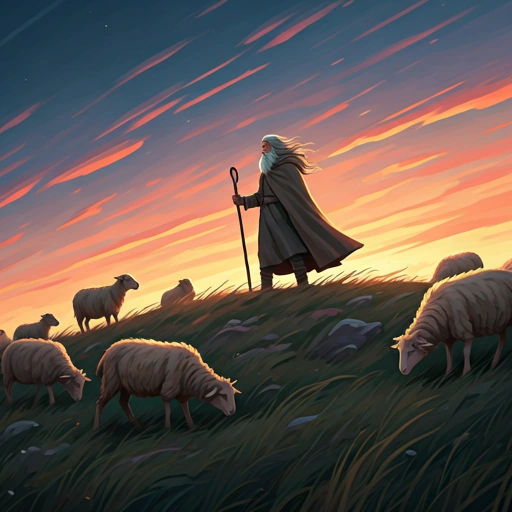
In the vast, windswept plains of Patagonia, where the jagged peaks of the Andes Mountains met the boundless expanse of the sky, a land sculpted by glaciers and kissed by relentless winds, lived a young shepherd named Kai. He spent his days tending to his small flock of hardy sheep, his only companions the grazing animals, the majestic soaring condors that circled overhead, and the ever-present wind, a constant force that shaped the landscape and whispered secrets across the plains. Kai was a quiet, introspective soul, more comfortable in the company of nature than with the clamor of human interaction. He found solace in the vastness of the landscape, the predictable rhythm of the seasons, and the constant, almost sentient whisper of the wind, a voice that seemed to permeate every aspect of his existence.
One day, as the sun dipped below the horizon, painting the sky in hues of fiery orange and deep violet, a traveling storyteller, an old Mapuche woman named Ayelen, arrived at Kai’s humble stone hut, seeking shelter for the night. She carried with her a worn leather bag overflowing with stories, passed down through countless generations, tales of ancient spirits that inhabited the mountains, of the profound interconnectedness of all living things, and of the deep wisdom held within the natural world, waiting to be discovered by those who knew how to listen.
Intrigued by her presence, by the quiet strength that emanated from her, Kai offered Ayelen the simple hospitality his hut could provide. Over the next few days, as the wind continued its ceaseless song outside, she shared her stories with him, weaving tales that resonated deeply within his soul, awakening a longing for a connection he hadn’t fully understood he was missing. One evening, as the wind howled with particular ferocity, shaking the very foundations of the hut, Ayelen told Kai about the “Language of the Wind.”
“The wind,” she explained, her voice low and resonant, like the deep rumble of distant thunder, “is not merely a meteorological phenomenon, a force of nature to be reckoned with. It is a messenger, a carrier of ancient wisdom, a tangible breath of the Great Spirit that permeates all of creation. It speaks to those who possess the patience and the open heart to truly listen.”
Kai, captivated by her words, his eyes wide with curiosity, asked, “But how does one learn to listen to the wind, Nanna Ayelen? It seems like nothing but a chaotic roar.”
Ayelen smiled gently, a knowing smile that spoke of deep understanding. “It is not with the ears of the body that one hears the true language of the wind,” she said, her voice soft as the rustling of leaves, “but with the ears of the heart, with the intuitive knowing that resides within each of us. One must first quiet the incessant chatter of the mind, open the heart to receive, and allow the wind to speak its secrets, to reveal its hidden messages.”
After Ayelen departed, leaving behind a lingering sense of peace and a seed of profound understanding, Kai began to dedicate more time to truly listening to the wind. He would often climb the highest hill overlooking the vast plains, watching the tall grasses sway in rhythmic waves, observing the dance of the clouds across the sky, and listening intently to the varied tones of the wind as it rushed past his ears. At first, he heard only the physical sounds: the whistling, the howling, the rustling of the grass, the sharp bite of the icy air. But gradually, as he practiced quieting his mind, focusing his attention inward, and opening his heart to the subtle energies around him, he began to perceive something far more profound.
He started to notice subtle shifts in the wind’s tone, delicate variations in its intensity, intricate patterns in its rhythm, like a complex melody being played on an invisible instrument. He felt as though the wind was trying to communicate something deeply personal, something profound, but he couldn’t quite grasp its full meaning, as if he were listening to a language he had once known but had long forgotten.
One day, a fierce, almost apocalyptic storm swept across the Patagonian plains. The wind raged with unrestrained fury, tearing at the landscape, the rain poured down in torrents, and the thunder echoed through the mountains like the drums of ancient gods. Kai, instead of seeking shelter in his small hut, felt an inexplicable urge to go out into the heart of the storm. He climbed the familiar hill, letting the wind buffet him, letting the icy rain wash over him, letting the raw power of the storm penetrate his very being.
As he stood there, exposed to the elements, something profound shifted within him. He felt a deep, visceral connection to the storm, a sense of being an integral part of something vast, ancient, and immensely powerful. And then, in the midst of the roaring wind and crashing thunder, he heard it. Not with his physical ears, but with an inner knowing, a deep intuitive understanding that resonated within the very core of his soul.
The wind was not just a chaotic, destructive force; it was a complex, interconnected symphony of energy, a constant exchange of vibrations between the earth, the sky, the mountains, the rivers, and all living things. He felt the wind carrying the whispered secrets of the mountains, the gentle songs of the rivers as they carved their paths through the valleys, the lonely cries of the condors circling high above. He felt the wind carrying his own thoughts, his own feelings, his own longings out into the world, connecting him to everything around him in a profound and tangible way.
He finally understood that the language of the wind was not a language of human words, of structured grammar and syntax, but a language of feeling, of intuition, of deep, intuitive connection, a language that spoke directly to the heart, bypassing the analytical mind.
From that day forward, Kai’s relationship with the wind underwent a profound transformation. He no longer merely heard it as a physical sound; he truly listened to it with his heart. He learned to discern its subtle messages, its gentle guidance, its profound wisdom. He found that the wind could offer comfort in times of sorrow and loss, inspiration in times of doubt and uncertainty, and deep, ancient wisdom in times of confusion and searching.
He began to share his newfound understanding with others in his community, teaching them how to listen to the wind, how to reconnect with the natural world, how to find their own inner wisdom through this profound connection. He became known as Kai, the Wind Listener, a bridge between the human world and the world of nature, a conduit for the ancient wisdom that the wind carried on its breath. He understood that the language of the wind was a universal language, accessible to all who were willing to quiet their minds, open their hearts, and truly listen.
————
Interpretation:
This tale uses the powerful metaphor of the “Language of the Wind” to represent intuition, inner wisdom, the interconnectedness of all things, and the profound wisdom inherent in the natural world. The wind symbolizes the subtle energies, messages, and intuitive insights that constantly surround us, waiting to be perceived and understood.
Philosophical and spiritual ideas explored:
- Inner Wisdom and Intuition: The story emphasizes the existence of an inner wisdom, a deep intuitive knowing that resides within each of us. This wisdom can be accessed by quieting the mind, opening the heart, and cultivating a deep connection to our inner selves. The wind serves as a catalyst for this inner awakening.
- Connection to Nature as a Source of Wisdom: The tale highlights the profound importance of connecting with the natural world. Nature is not merely an external environment but a living, breathing entity, a source of profound wisdom, inspiration, healing, and spiritual connection. Listening to the wind is a metaphor for listening to the wisdom of nature itself.
- The Language of Feeling and Intuition: The story emphasizes that the true language of the wind, and by extension, the language of the universe, is not a language of words or logical reasoning, but a language of feeling, of intuition, of deep, visceral connection. It speaks directly to the heart, bypassing the limitations of the analytical mind.
- Interconnectedness of All Things: The wind symbolizes the interconnectedness of all things in the universe, carrying messages and energy between different elements of the natural world and connecting us to everything around us. This interconnectedness emphasizes the importance of respecting all forms of life and recognizing our place within the larger web of existence.
- The Power of Stillness and Observation: The story highlights the importance of cultivating stillness and practicing deep observation as a means of accessing inner wisdom and connecting with the natural world. By quieting the noise of the mind and focusing our attention on the present moment, we can open ourselves to receive the subtle messages that are constantly being offered to us.
- The Storm as a Catalyst for Transformation: The storm serves as a powerful catalyst for Kai’s transformation, forcing him to confront his fears, surrender to the power of nature, and open himself to a deeper level of understanding. It represents the challenges and disruptions that can lead to profound personal growth and spiritual awakening.
The story’s overarching message is one of profound connection, inner wisdom, and the transformative power of listening to the subtle messages of the natural world. It encourages readers to cultivate their intuition, to reconnect with nature, and to quiet the noise of the mind in order to hear the whispers of the heart, the language of the wind. It reminds us that wisdom is not just found in books or teachings but also within ourselves and in the natural world that surrounds us, waiting to be discovered by those who are willing to listen with an open heart and a receptive spirit. The emphasis is on the journey inward, the development of intuitive understanding, and the profound interconnectedness of all life.
